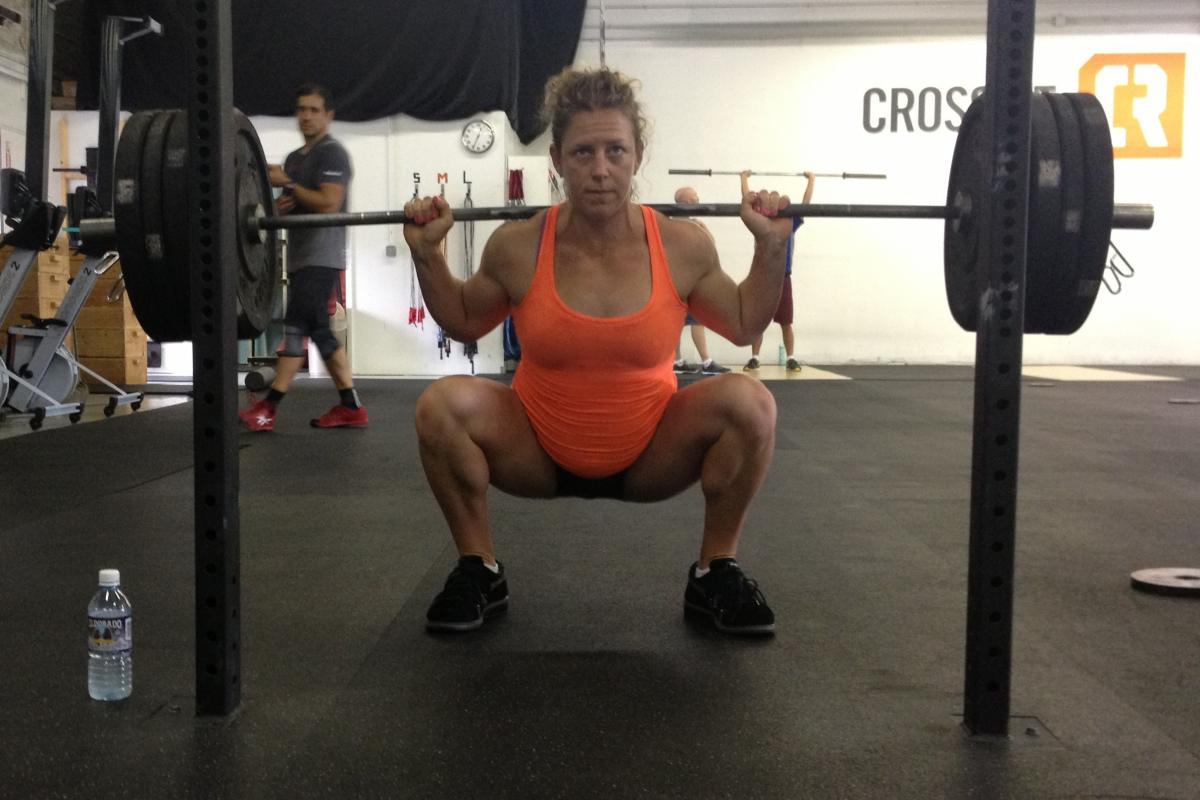The Local newsletter is your free, daily guide to life in Colorado. For locals, by locals.
Last September, Nicole Christensen curled her left hand around a 45-pound dumbbell and her right around another at Boulder’s CrossFit Roots gym. Then, with slightly bent knees, she raised one weight and then the other above her head—30 times in a row.
Christensen finished her reps in just three minutes, which was quick, even for her. Christensen is a competitive CrossFit athlete (she finished in the top 10 of the southwest regional qualifier for the CrossFit Games three times in recent years), plus she is a certified CrossFit coach and owns the gym she was working out at on that fall day. So, in the midst of others doing pull-ups, hefting barbells, or doing squats, Christensen shouldn’t have stood out.

But something was different: Christensen’s profile. Her bright blue tank top and black shorts stretched across her extended belly. She was late in her third trimester and due to give birth to her first child any day. Reckless? Crazy? Not to her.
CrossFit, a strength and conditioning workout regime that combines aerobic and weightlifting exercise, was created in 2000 and has more than a million devotees today. Followers complete daily workouts that include anything from running and rowing to kettle bell swings and pull-ups. The movement has turned ho-hum gym workouts into competitive I-can-beat-you battles.
Devotees are maniacal about consistency and training schedules, so it isn’t surprising that Christensen wasn’t about to take time off. “In the first book I read, the woman takes a nine-month vacation from working out,” Christensen says. “That’s not a way to grow a healthy baby.” She consulted with her doctor throughout her pregnancy to make sure the baby was healthy, and continued CrossFit workouts five days a week. Well into her third trimester, she was squatting up to 175 pounds and dead-lifting nearly 100 pounds.
There are risks to that sort of intense pregnancy workout, though, explains Doctor Jaime Arruda, University of Colorado assistant professor in Obstetrics and Gynecology. “I think that with the right modifications, most women can continue to do most exercises during pregnancy,” she says. “But I think someone who is running three to five miles a day is different than someone maxing out at CrossFit.”
Arruda, who ran during her own three pregnancies, says that CrossFit workouts could cause falls or abdominal injury from weight-bearing movements. The common practice of Valsalva breathing—holding your breath—while lifting could limit oxygen supply to a fetus. She is quick to point out, though, that due to the obvious risks posed by conducting research on expectant mothers and unborn babies, Valsalva breathing’s impact has never been studied. In fact, very few studies have examined doing extreme fitness while pregnant. One of those is a Norwegian study that followed six pregnant Olympic-level athletes. It found that when pushing their heart rate to more than 90 percent, the fetal heart rate temporarily dropped below what is considered normal until the intensity decreased.
But the biggest risk for pregnant moms is probably not working out too much. “Across America, the issue isn’t that [pregnant women] exercise too much, but that they exercise too little,” Arruda says. A study released by the National Institutes of Health found that 73 percent of woman accumulate more than their recommended weight gain during pregnancy, which can lead to health problems for the child (increased likelihood of adult obesity) and the mother (vaginal tearing during labor). Doctor Jim Pivarnik is the director of the Center for Physical Activity and Health at Michigan State University and has studied the effects of exercise for pregnant women since 1986. “Other than avoiding activities that might involve blunt trauma she can perform mostly what she did before,” Pivarnik says, “Assuming that she backs off if she begins to fatigue more than usual and her doctor says it is OK.” So what’s the right balance?
Andrea Nitz, a certified pre- and postnatal exercise trainer based in California founded CrossFit Mom and scales workouts for the first, second, and third trimester. Nitz estimates that she has coached dozens of pregnant women one-on-one at her gym and hundreds virtually, and has found that most of them have few physical complaints. “They are not burdened with the usual lack of energy, low back pain, and other ailments,” Nitz says. “And they have easier pregnancies, right through labor and delivery.”
Christensen also believes in scaled workouts. “My goal was to never leave the gym and regret something I had done,” she says. Christensen has coached eight pregnant women and she avoids things a soon-to-be-mom would feel uncomfortable with, like barbells whipping past her belly.
Christensen, who gave birth to a healthy baby girl in the fall, knows that not everyone was—or will be—comfortable with her regimen. “I definitely got some comments during the nine months, positive and negative,” she says. “But in the end, I had a great delivery. The baby is healthy. I’m healthy. And that is the best way I know how to respond to the criticism.”
—Image of Nicole Christensen courtesy of Hillary Harris








